By: Lauren Cecconello
Overview
This project aims to find the significant changes in Japanese ceramics from the traditional to the contemporary and the catalyst(s) for these changes during the Edo period. The traditional is defined as the Muromachi and Momoyama periods (1336-1600), and the contemporary ranges from the Meiji period (1868-1912) to the present. I believe this topic is closely tied to the question of “What is Japan-ness?” because these evolutionary changes in art are what Japanese art was, is, and continues to become. Traditional art can show what may have been widespread, controversial, or essential during that time. When the same ideas are studied in art throughout history, minor and significant changes can be found that may shed light on other historical mysteries. I am passionate about this topic because I have been making ceramic work for the past four years. After taking this class, I realized that some of my work had been unintentionally influenced by Japanese art styles – simplicity, use of negative space, and minimalist forms. On a more personal note, I chose to focus on the Edo period as a “transitional” period because I tend to find myself as the middle ground in many aspects. So, in that way, I feel a personal connection to these pieces and their creation.
Throughout this project, I talk about Japanese ceramic pieces ranging from the traditional to Edo and stretching into contemporary periods. Although there are no visuals of contemporary ceramics due to the lack of free-use Creative Commons licenses, there will be links below. The traditional era served as a “beginning” to the cultural changes in art that would soon happen in the Edo period. The Edo period then bridges the “then” and the “now” of Japanese art, as it incorporates ideas from both eras and gives itself a whole new identity. Subsequently, the contemporary era became a distinctive age of innovation while still appreciating the art from the traditional and Edo periods.
In my exploration of Japanese art, I looked through two academic texts, the first being “Religion and Society in the Edo Period, as Revealed in the Thought of Motoori Norinaga,” which encapsulates Japanese Religion and Society in the Edo period. The second artile, “6 The Edo Period: Confucianism, Nativism, and Popular Religion”, focuses on other belief systems and women’s roles during this time. In the first article, there was a lot of discussion about the regularly practiced religions in Japan, such as Buddhism and Shintoism. Interestingly, however, a very different religion was introduced to Japan when Ieyasu Tokugawa was proclaimed the newest emperor. This was a significant turn point because Ieyasu founded the first shōgun in 1603 (the beginning of the Edo period) and ruled with a lot of militant and orderly intent. At first glance, this was a bit contradictory because, during this time, art was evolving and did not seem to incorporate many military depictions or quality to it. When I thought about it more, the new art forms coming out of this time were most likely people’s way of expressing themselves when they lived in such an orderly and constrictive time. The Edo period was also the same time the potter’s wheel became more popular (even though it had already been introduced to Japan), so using new technology and the need for individual expression was part of the catalyst for forming new ideas and techniques. The second article discusses what women could and could not do. For instance, Tadano Makuza, an intellectual, actively defends the fact that women can be successful and have ambitions equivalent to men and talks about what was expected of women in this and previous generations. Having successful women bring up topics like these allowed other women to become creative and successful. Especially in the art scene, this allowed more and more women to be seen as accredited artists and opened up new ways of thinking in the field.
Traditional Art
Muromachi and Momoyama art have defining features such as earthen tones, classic blue and white tones, hand-built forms, double-gourd shapes, and negative space in illustrations. Two pieces from the Traditional era that depict some of these features are a Wide-Mouth Jar and a Dish with Plum Trees (images below)
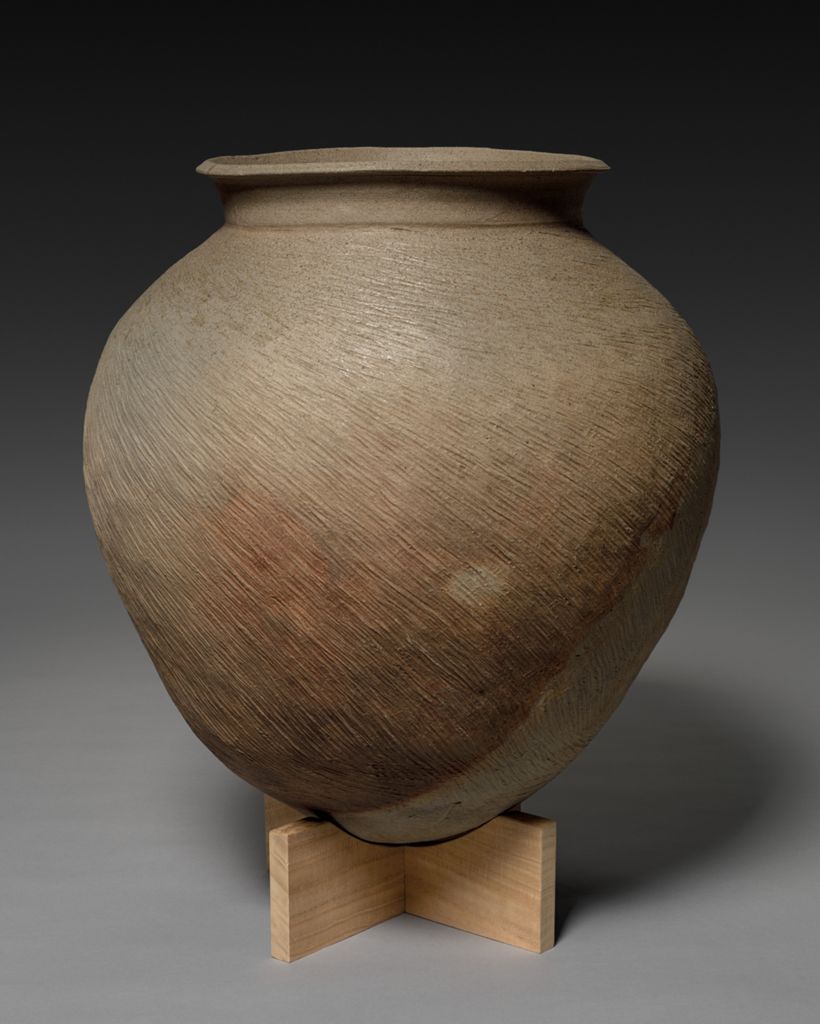
Creator: unknown
Title: Wide-Mouth Jar
Measurements: Diameter: 53 cm (20 7/8 in.); Overall: 56.5 cm (22 1/4 in.)
Medium: Ceramic – Stoneware
Date: 1300s
Repository: The Cleaveland Museum of Art – Cleveland, Ohio, USA – Gift from the Collection of George Gund III
Culture: Japanese (Muromachi)
Source: Wide-Mouth Jar (artstor.org)
This jar is a beautiful example of traditional Japanese art due to its earthen tones and vast body, and it was undoubtedly made to meet needs like holding water or food. The jar is also Suzu ware, fired in a sizeable tunnel-like kiln covered in streaks. They are commonly found on the coast and were widely sold in coastal trade.
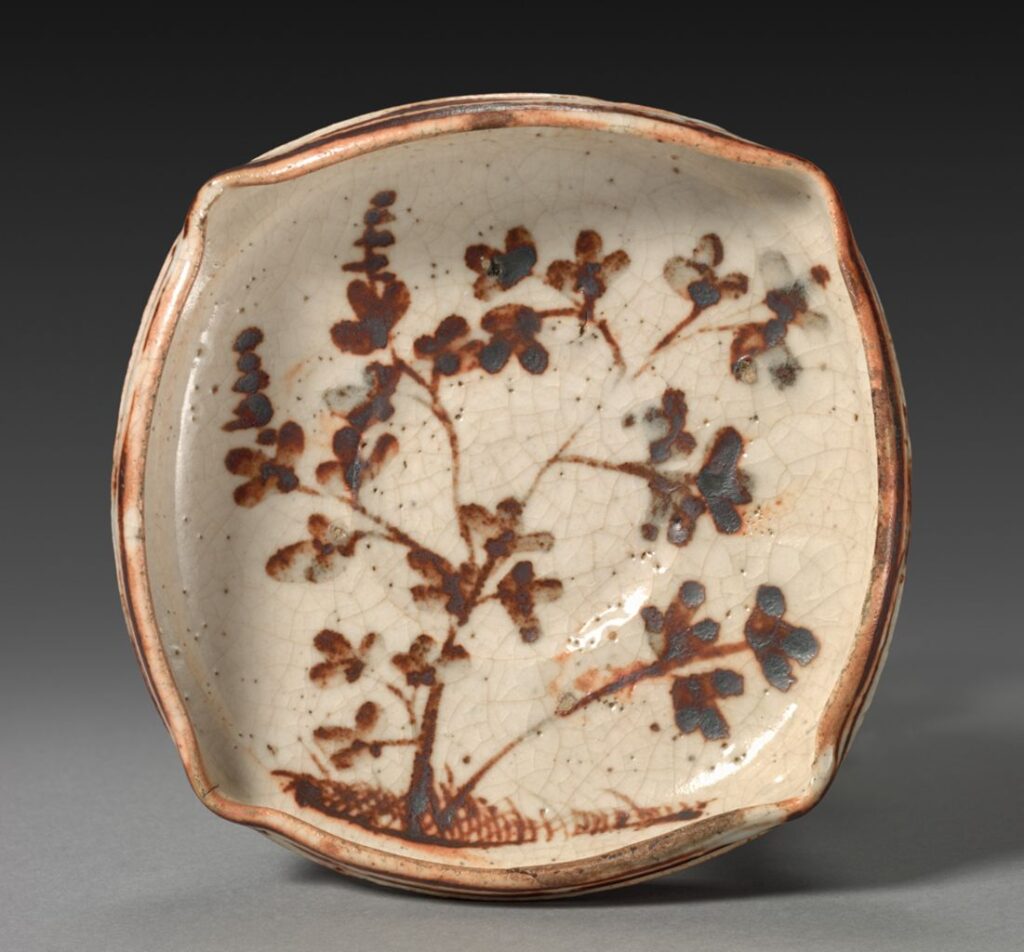
Creator: unknown
Title: Dish with Design of Plum Trees
Measurments: Overall: 5.1 x 17 cm (2 x 6 11/16 in.)
Medium: Ceramic
Date: late 1500s
Repository: The Cleaveland Museum of Art – Cleveland, Ohio, USA – James Parmelee and Cornelia Blakemore Warner Funds
Culture: Japanese (Momoyama)
Source: Dish with Design of Plum Trees: Shino Ware (artstor.org)
Similarly to the jar above, this dish is used for necessities such as carrying food or holding someone’s belongings. The dish was also handbuilt, filled with earthen tones, and utilizes negative space behind the depiction of plum trees.
Contemporary Art
Unfortunately, I could not picture any Meiji or contemporary pieces due to their lack of Creative Commons Licenses, but there are reference links below where the pieces can be observed.
Meiji
Teapot: Teapot (artstor.org)
Vase: Vase (artstor.org)
Hexagonal Box: Hexagonal Covered Box (artstor.org)
In the Meiji Period, ceramic art became more detail-oriented, incorporated more color, used higher quality materials (such as porcelain), and started teapot creation, which had not been seen before due to its complex nature.
Contemporary
Crinkle Super Bag: Crinkle Super Bag Vase V-1 (artstor.org)
Crinkle Vase: Crinkle Vase KNS-2 (artstor.org)
Wink: Wink (artstor.org)
Contemporary Japanese Art somewhat references traditional Japanese art in that most colors used are black, white, or light blue (simplifying the blue and white designs). In contrast, making art for necessity is much less common, and these pieces are typically made for art’s sake (especially example #3).
The Edo Period
The Art of the Edo period is the first step towards Modern and Contemporary Japanese Art. Art from this time combined traditional and modern styles to form pieces harmonizing both.
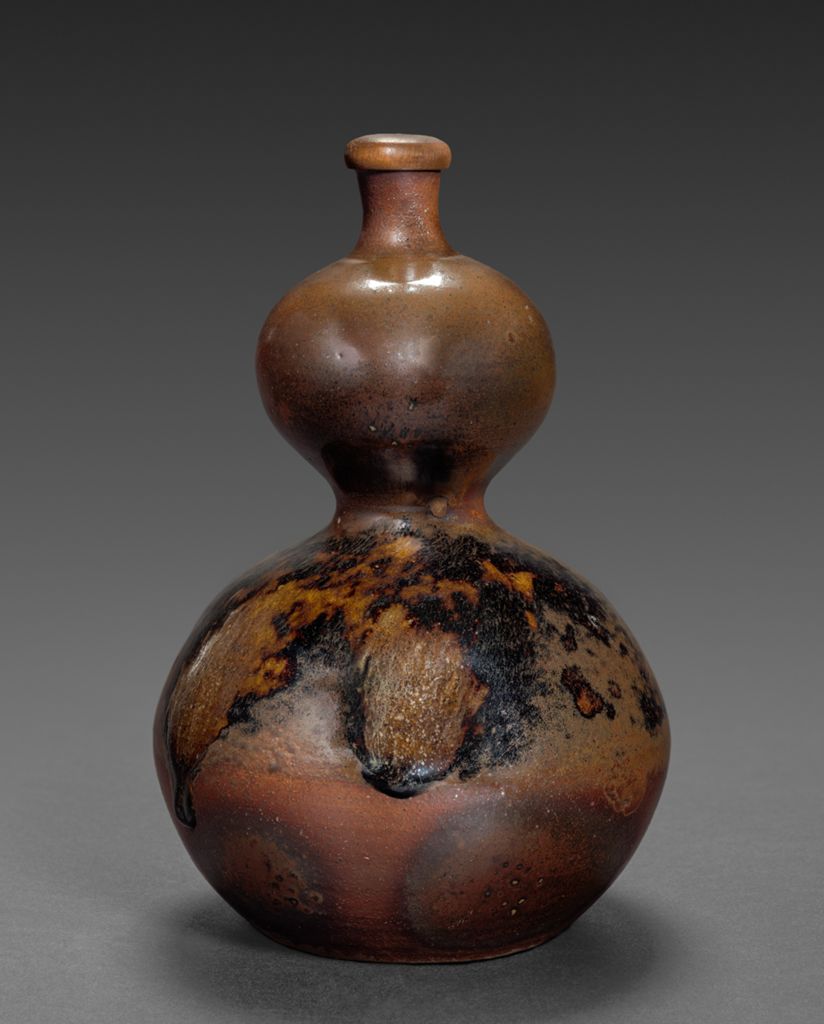
Creator: unknown
Title: Double Gourd Jar with Wooden Stopple
Measurements: with stopple: 16.9 cm (6 5/8 in.); without stopple: 15.6 cm (6 1/8 in.)
Medium: Ceramic – Stoneware
Date: 1700S to mid-1800S
Repository: The Cleveland Museum of Art – Cleveland, Ohio, USA
Culture: Japanese (Edo)
Although not included in the traditional era images, two common shapes of Japanese ceramics for many generations were the gourd and the double gourd. Symbolic of the Edo period, this piece incorporates the Traditional era by making this earthen-toned double-gourd shape while incorporating more modern techniques. For instance, the small size of this double gourd’s cinch was only easily achieved with the use of a potter’s wheel, which had only recently become popular as the Edo period began. The potter’s wheel also improved artists’ abilities to make a more symmetrical piece and provide more stability when used skillfully.

Creator: unknown
Title: Chrysanthemum Censer
Measurements: Overall: 24.2 cm (9 1/2 in.)
Medium: Ceramic (Porcelain)
Date: 1700s
Repository: The Cleveland Museum of Art – Cleveland, Ohio, USA
Culture: Japanese (Edo)
This Chrysanthemum Censer is an excellent representative of the Edo period because it is very detailed and not needed for necessity while being entirely covered in classic Japanese blue and white glaze. Though designs of nature and flowers have been widespread in Japanese art, the level of detail and carving of the Chrysanthemum flower would have been relatively uncommon before this period because, previously, art was only made for necessity. With less demand for ceramic necessities, more time could have been put into details, and this level of decor slowly became more common and a standard.
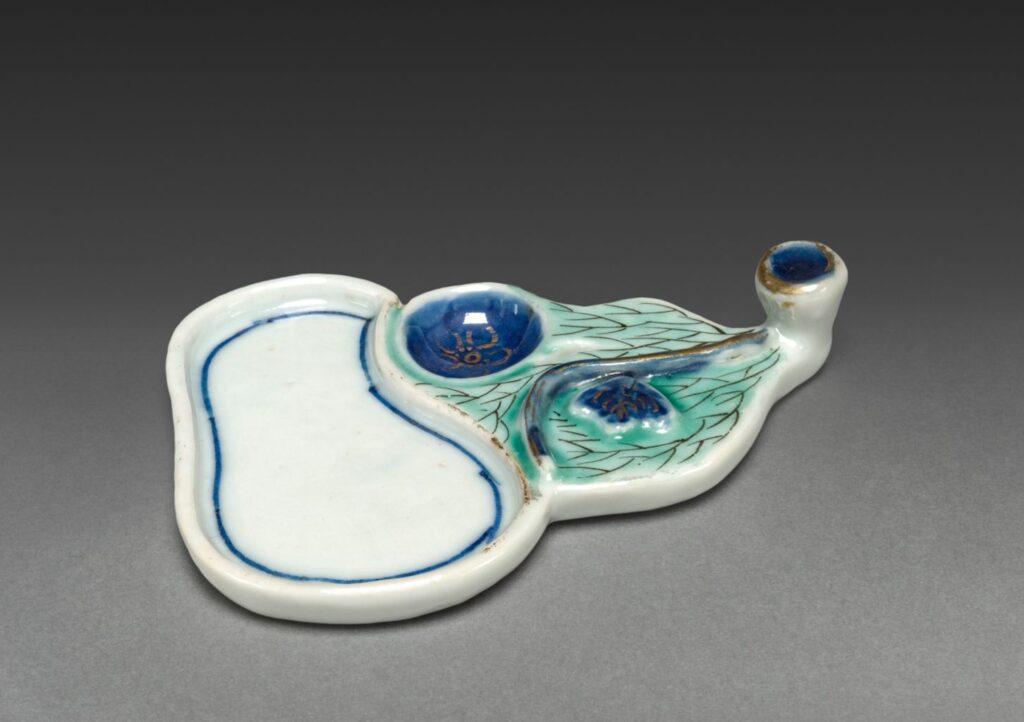
Creator: unknown
Title: Ink Palette in the Shape of a Gourd
Measurements: undisclosed
Medium: Ceramic (Porcelain)
Date: 1700s to mid-1800s
Repository: The Cleveland Museum of Art – Cleveland, Ohio, USA
Culture: Japanese (Edo)
This Ink Palette is inherently connected to the Modern and Contemporary periods due to its purpose of holding ink but still connects to Japanese roots with its gourd shape, usage of negative space, and representation of nature. This Ink Palette was also constructed from porcelain, which was introduced to Japan in the early seventeenth century (during the Edo Period) and became immensely popular.
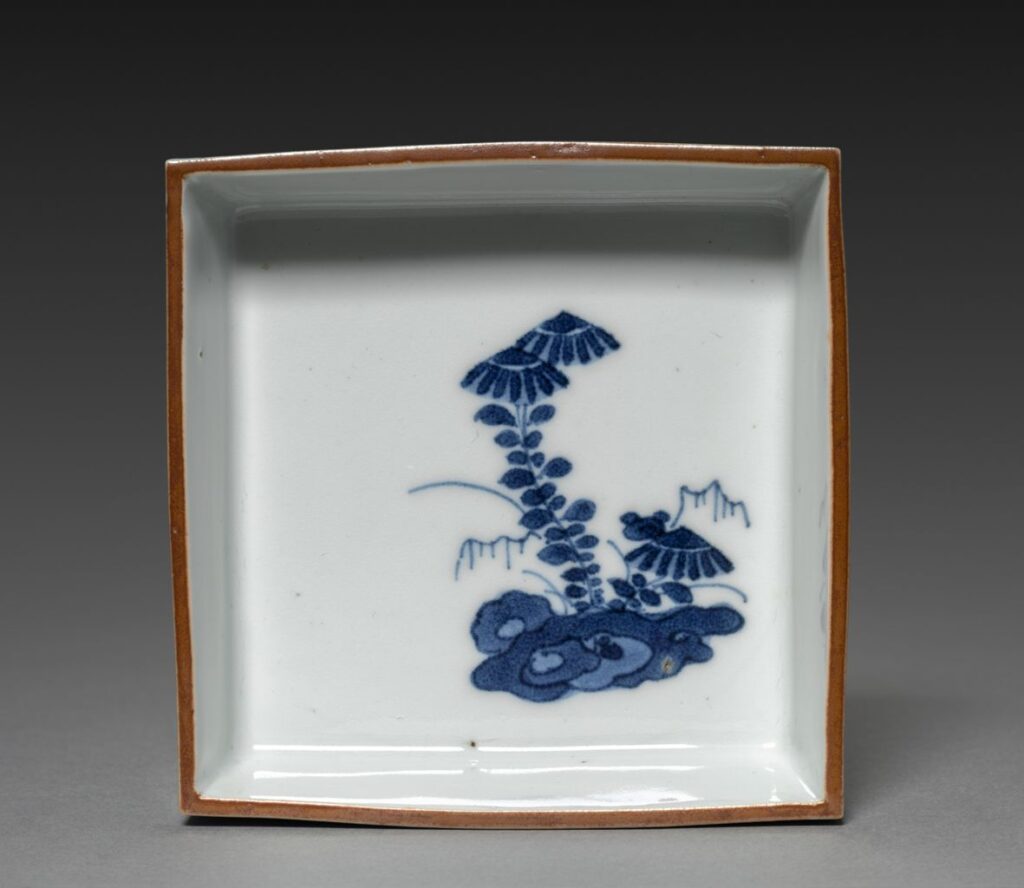
Creator: unknown
Title: Side-Dish with Dandelion in Rocks
Measurements: Diameter: 11.8 cm (4 5/8 in.)
Medium: Ceramic
Date: 1700s
Repository: The Cleveland Museum of Art – Cleveland, Ohio, USA
Culture: Japanese (Edo)
This square-shaped dish is another beautiful example of the Edo period because it has the Japanese blue and white theme and uses a lot of negative space on the interior and exterior. Another traditional feature that has yet to be seen in my previous examples is the use of gold around the dish’s rim. In Japan, gold is often used to fix broken pieces of dinnerware or art to represent beauty in imperfections. Gold is also commonly associated with religion, especially Buddhism, is used to decorate many shrines, and is otherwise culturally significant throughout Japanese history. Although handbuilt, this dish’s smooth square shape makes it relatively modern because this shape is almost only seen during and following the Edo period.
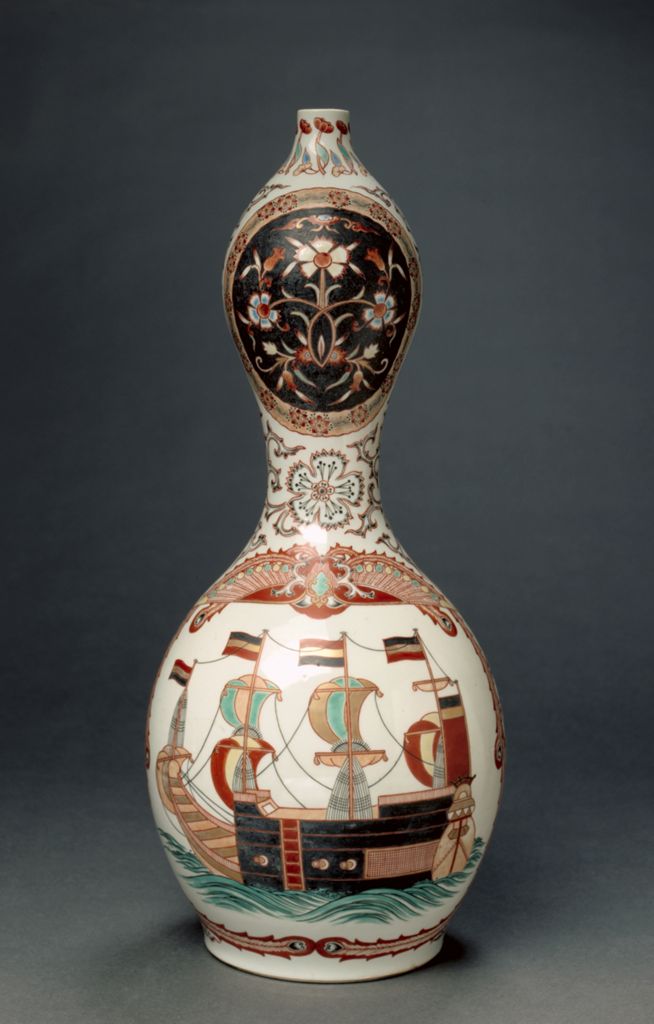
Creator:
Title: Bottle with Western Ships
Measurements: Overall: 55.9 cm (22 in.)
Medium: Ceramic (Porcelain)
Date: 1800 – 1868
Repository: The Cleveland Museum of Art – Cleveland, Ohio, USA
Culture: Japanese (Edo)
This bottle is my favorite example of art from the Edo period because it is a traditional double-gourd shape incorporating negative space in the background but also contains many modern components. Some of these include the usage of porcelain, the symmetry achieved with a potter’s wheel, a substantial amount of detail, and, most importantly, the design of Western Ships. In correlation with the creation date, this piece is undoubtedly part of the Edo period but feels much closer to the contemporary than the previous examples due to the amount of modern/contemporary features it has.
Conclusion
Overall, the evolution of “Japan-ness” in ceramic art has drastically changed from the traditional, to the Edo period and into the contemporary era. From the inspiration birthed out of the new military-governed era came new customs, artistic styles, and ideas that formed what we call “Japanese” today. In terms of the Art community, the Edo period has contributed a freedom in art expression while still incorporating and honoring Japanese history.
Bibliography
- Willmann, Anna. “Edo-Period Japanese Porcelain.” In Heilbrunn Timeline of Art History. New York: The
Metropolitan Museum of Art, 2000–. http://www.metmuseum.org/toah/hd/jpor/hd_jpor.htm (April 2011) - Atushi, Imai. “Japanese Ceramics of the Azuchi-Momoyama and Edo Periods.” Elegant Perfection:
Masterpieces of Courtly and Religious Art from the Tokyo National Museum, The Museum of Fine Arts,
Houston, Houston, TX, 2011, pp. 82–105. - Hirota, Denis. “Buddhist Thought and the Way of Tea.” Steeped In History, edited by Beatrice Hohe, Fowler
Museum UCLA, Los Angeles, CA, 2009, pp. 60–83. - Lurie, Samuel J., and Beatrice L. Chang. “Introduction – Kyoto Region.” Fired with Passion: Contemporary
Japanese Ceramics, First Edition ed., Eagle Art Publishing, Inc., New York City, NY, 2006, pp. 1–56. - “Edo Period (1603 – 1868).” Japanese History: Edo Period, 18 Nov. 2002, www.japan-guide.com/e/e2128.html.
- Masahide, Bitō. “Religion and Society in the Edo Period, as Revealed in the Thought of Motoori Norinaga.” Modern Asian Studies 18, no. 4 (1984): 581–92. http://www.jstor.org/stable/312336.
- Ambros, Barbara R. “The Edo Period: Confucianism, Nativism, and Popular Religion.” In Women in Japanese Religions, 97–114. NYU Press, 2015. http://www.jstor.org/stable/j.ctt15r3zhw.10.
Image Citations
- 1700s to mid-1800s. Double Gourd Jar with Wooden Stopple. Ceramic. Place: The Cleveland Museum of Art, Cleveland, Ohio, USA, Collection: Japanese Art, Department: Japanese Art, Bequest of James Parmelee. https://library.artstor.org/asset/24589202.
- 1700s. Chrysanthemum Censer / 染付菊文透彫香炉, See all records within the set</ A>. Ceramic. Place: The Cleveland Museum of Art, Cleveland, Ohio, USA, Collection: Japanese Art, Department: Japanese Art, The Holden Collection. https://library.artstor.org/asset/24568651.
- 1700s to mid-1800s. Ink Palette in the Shape of a Gourd. Ceramic. Place: The Cleveland Museum of Art, Cleveland, Ohio, USA, Collection: Japanese Art, Department: Japanese Art, Provenance: description: (William H. Lautz, New York, NY, sold to Severance and Greta Millikin); footnotes: None; date: ?–1961, description: Severance A. [1895–1985] and Greta [Marguerite Steckerl] Millikin [1903–1989], Cleveland, OH, given to the Cleveland Museum of Art; footnotes: None; date: 1961–1989, description: The Cleveland Museum of Art, Cleveland, OH; footnotes: None; date: 1989–, Bequest of Mrs. Severance A. Millikin. https://library.artstor.org/asset/24619526.
- 1700s. <!– –>Side-Dish with Dandelion in Rocks, See all records within the set. Ceramic. Place: The Cleveland Museum of Art, Cleveland, Ohio, USA, Collection: Japanese Art, Department: Japanese Art, Provenance: description: (Johnstone-Fong, Kennett Square, PA, sold to Gordon K. Mott); date: ?-1992, description: Gordon K. Mott [1914-1998], Lakewood, OH, bequest to the Cleveland Museum of Art; date: 1992-1998, description: The Cleveland Museum of Art, Cleveland, OH; date: 1998-, Bequest of Gordon K. Mott. https://library.artstor.org/asset/24621239.
- 1800–1868. Bottle with Western Ships. Ceramic. Place: The Cleveland Museum of Art, Cleveland, Ohio, USA, Collection: Japanese Art, Department: Japanese Art, Provenance: description: Ralph King [1855–1926], Cleveland Heights, OH, given to the Cleveland Museum of Art; footnotes: None; date: ?–1919, description: The Cleveland Museum of Art, Cleveland, OH; footnotes: None; date: 1919–, Gift of Ralph King. https://library.artstor.org/asset/24569190
- 1300s. Wide-Mouth Jar. Ceramic. Place: <a href=’https://www.clevelandart.org/’>The Cleveland Museum of Art</a>, Cleveland, Ohio, USA, Collection: Japanese Art, Department: Japanese Art, Gift from the Collection of George Gund III. https://library.artstor.org/asset/24628512.
- late 1500s. Dish with Design of Plum Trees: Shino Ware. Ceramic. Place: <a href=’https://www.clevelandart.org/’>The Cleveland Museum of Art</a>, Cleveland, Ohio, USA, Collection: Japanese Art, Department: Japanese Art, James Parmelee and Cornelia Blakemore Warner Funds. https://library.artstor.org/asset/24611949.